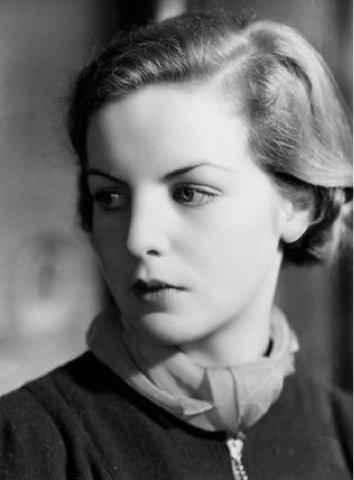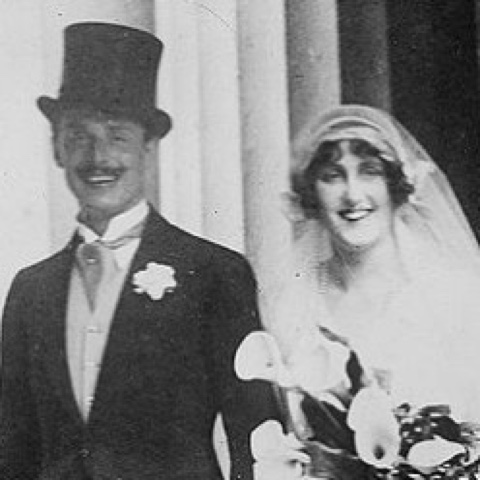Not long ago I read a very good book Nancy Mitford A Biography by Selina Hastings. This was my first immersion into the world of the famous and infamous Mitford Sisters. I wanted to learn more about the sisters and the milieu in which they lived. I am into "faded" aristocrats, relishing the unconventional, savoring the decadent, accepting the fey alongside the forthright. On a personal note I have three daughters of my own, one just at the age when Diana Mitford destroyed her seemingly fairy tale marriage to a member of the fabulously wealthy Guinness to become the mistress of Oswald Mosley, notorious as the leaders of British Fascist Union and a passionate admirer of Adolph Hitler, so I had to wonder how six girls all raised more or less the same can have such different personalities.
1910 to 2003
Diana was born into an affluent aristocratic English family. She had five sisters, including the novelist Nancy Mitford, and one brother, Tom. She was the fourth child and the third daughter. Her father was a baron. Their maternal grandfather was Thomas Gibson Bowles, the founder of two still in print British Magazines, The Lady and Vanity Fair. Spence did a great job of making the early years of Diana come to life for me. But for six months at a Paris boarding school, Diana was home schooled by a frequently changing series of governess. Their father did not especially believe in education for girls. Diana's parents were rich land but her father was not a great business man and they did sometimes struggle to maintain a proper life style. She was a cousin of Clemintime Churchill and a second cousin of Bertrand Russell.
Of course as anyone who has read Victorian novels knows, the biggest issues on the minds of the sisters and their parents was getting them properly married. Spence evokes the tension and drama this involves. Of course a suitable husband must come from old money and preferably be in line to inherit a title. Spence talks about the big coming put event for the girls, presentation to the queen, signaling they are "on the market". Diana was an incredible beauty and soon became engaged to Bryan Guinnesses from the hyper-wealthy beer family. We can see the manipulative personality of Diana in the opening stages of her relationship with Bryan. At first her parents thought the couple was too young to marry but Bryan was guaranteed a princely income for life so they were married. Spence lets us see the real passion Bryan had for Diana and we also are shown perhaps based on practicality her lesser love. Diana gave birth to sons in 1930 and 1931. They owned a large estate and beautiful townhouses in Dublin and London. Diana hosted parties for high society young and mingled with literary figures like Evelyn Waugh. I laughed when I learned his wife was also named Evelyn and he was called "he Evelyn". They, as directed by Diana, socialized with a "campy" sort of crowd. If it were not for a man Diana was to meet and fall in total love with, as she never did with Bryan, in 1932 she would be remembered mostly as the sister of the novelist, Nancy Mitford.
January 30, 1929 - Diana Marries Bryan Guinness
In February of 1932 Diana met, at a garden party, Oswald Moslsy, leader of the British Union of Fascists, the BUF. Mosley, a notorious womanizer from a wealthy family was at the time married to a daughter of Lord Curzon, a former Viceroy of India. His political goal was to turn England into a fascist society allied with the Nazis and Mussolini, with himself as national leader. At this period in England many of the wealthy feared the growing popularity of the communist party and were drawn to the idea of a strong man leader to keep the masses under control. Diana at once fell in love with Mosley, whose attitude toward women was almost openly predatory. His wife, who he did not want to divorce because of her much greater than his own wealth, tried to shrug of his relationships as just passing events but it iwas not easy. Mosley had affairs with numerous of her friends and a sister. Spence does a great job in detecting the dynamics involved. In the case of Diana his wife was deeply troubled by her great beauty. To make things all the weirder or worse, Diana's younger sister Unity Mitford, had fallen totally under the spell of Hitler, accepted his full ideology. She was only nineteen, of course Diana was still in her early twenties, and the appeal of Hitler for Unity seems to be a personal magnetism, almost sexual adoration of Hitler. Soon Diana told her husband Bryan she wanted a divorce, he was crushed as he very much loved her. I felt very sad for him as I read Spence's depiction of his emotions. At the time divorce could be granted only if one party had committed adultery so to save his wife shame Bryan falsely stated in court he had once hade sex with a prostitute while married. He even paid a woman to back this up in court. Bryan loved Diana so much he wanted to settle a large life time income on her but to her credit she took just £2500 a year.
Unity took her to Germany to go to Rallies to hear Hitler talk. Both sisters, initially knowing no German, felt Hitler was a great man, one who could save the world. Unity and Diana soon attracted the attention of top Nazi leaders, in apperance, tall and blond, it is said Hirler called them perfect examples of Aryan womanhood. Diana begins to learn German and does all she can to help Mosley with the BUF. Mosley has by now about fifty thousand members in the BUF, the most hardcore he forms into a "blackshirt" army which classes with Communist groups. As England and Germany seemed headed for war, Diana wants her country to side with the Germans, take over Europe and is at least unconcerned about Hitler's plans for the Jews.
Spence's account of Diana's fascination with Hitler and her involvement with high Nazi party members and the BUF was fascinating. Diana is completely in love with Mosley. Leaving out a lot of super interesting material you can learn about in Spence's great biography, after the death of Mosley's wife he and Diana are married in the private chambers of Goebbel's with Hitler in attendance.
October 6, 1936 Diana Marries Oswald Mosley
Diana's family and friends begin to see her involvement with the BUF as potentially dangerous to the interests of England. The close of the biography, written as well as a fine literary work, is very dramatic and I will leave it untold.
- Nancy Mitford (1904-1973)
- Pamela Mitford (1907-1994)
- Thomas Mitford (1909-1945)
- Diana Mitford (1910-2003)
- Unity Mitford (1914-1948)
- Jessica Mitford (1917-1996)
- Deborah Mitford (1920-2014
Not long ago I read a very good biography of Coco Chanel, Mademosille: Coco Chanel and the Pulse of History by Rhonda Garelick. In her account of Chanel's involvement with the Nazis and her love affair with a Nazi officer, probably directed by higher ups to draw information they thought she had from her many social contacts, Garelick goes into great depth explaining the inherent fascism in the designs of Chanel and in her fascination with Nazi uniforms and paraphnalia as much of the basis for the appeal of fascism. If you look at pictures of Diana and Unify, you can see the very strong influence Coco's designs had on their esthetic sensibility. The fascinating uniforms of the Nazis must have enthralled Diana and Unity, compared to the crumpled tweeds of English aristocratic men like their father, Churchill, or Bryan.
Mrs Guinness The Rise and Fall of Diana Mitford The Thirties Socialite by Lyndsy Spence is a wonderful biography and a valuable work of social history. Spence had access to letters and interviews with family members and associates of Diana to a greater degree than prior biographers.
Spence does not judge Diana, she presents her as person living in tumultuous times. I strongly endorse this book based on biographical excellence, social history, human insight as well as style.
Author Bio
Lyndsy Spence founded The Mitford Society, an online community dedicated to the Mitford girls. Her first book, The Mitford Girls' Guide to Life was published by The History Press in 2013, and her forthcoming books are Margaret Lockwood: Queen of the Silver Screen (Fantom Films, June 2016) and The Mistress of Mayfair: The Men, Money and Marriage of Doris Delevingne (The History Press, November 2016). She is the editor of The Mitford Society annuals which are sold on Amazon. She also writes book reviews for The Lady and has written features for BBC News Magazine, Social & Personal, Vintage Life and her local newspaper, the Antrim Guardian in Northern Ireland. She has a BA honors degree in Humanities with English Language and Literature, and a Diploma in Literature. She has 2 pets, a cat named Harriet and a dog named Lola, and loves heritage and old world aristocrats.
I am very glad I read Lyndsy Spence's finely done biography and I look forward to reading more of her work.
Mel u














2 comments:
Great review, thank you. I have read Mary S Lovell's "the Mitfird Girls". Fascinating family. This biography seems to be as fascinating.
The first photo is Deborah "Debo", the youngest sister.
Post a Comment